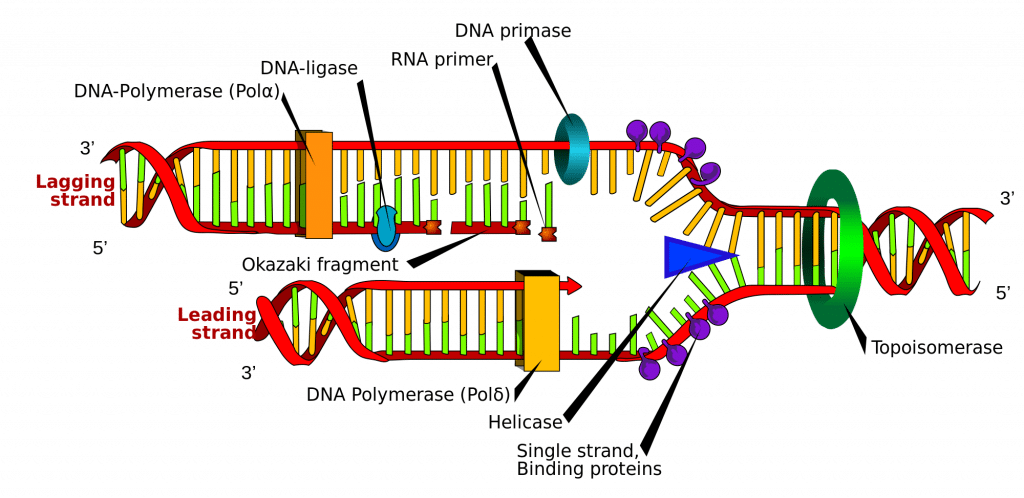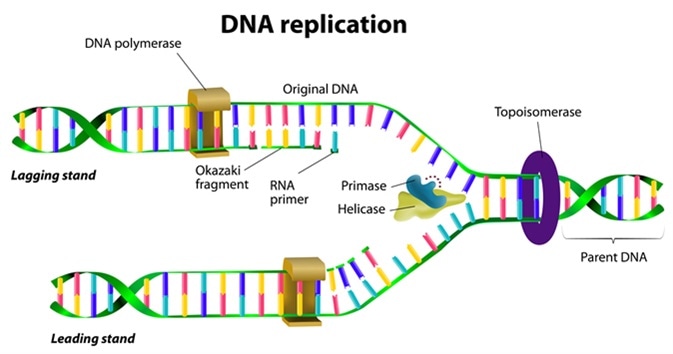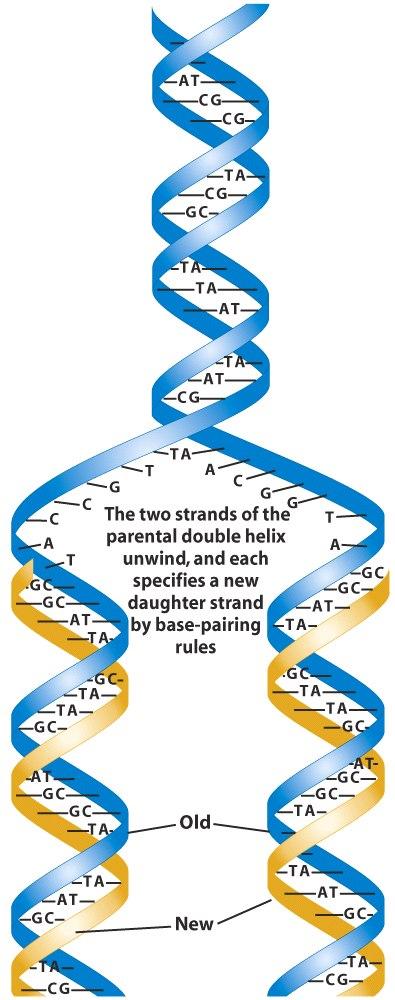Describe the Process of Dna Replication Using the Following Terms
Describe the process of DNA replication using the following terms. Stage 1- unwinds dna topomerase gyrase and helicase two strands of the double helix separate at the replication fork.

Dna Replication Structure Stages Of Replication Teachmephyiology
The cell cycle is divided into two main stages.

. DNA polymerase reads a parenttemplate DNA strand and adds complementary nucleotides to build a new strand of DNA. At the end of this process once the DNA is all replicated the cell actually has twice the amount of DNA that it needs and the cell can then divide and parcel this DNA into the daughter cell so that the daughter cell and the parental cell in many. DNA replication is the mechanism by which a cell unwinds the DNA double helix and duplicates both template strands before entering cell division.
Stage 2- synthesis includes primase and dna polymerase. It is also necessary for evolution and immune system response. DNA polymerase I DNA polymerase III helicase lagging strand leading strand ligase Okazaki fragments primase primers single-stranded binding proteins and topoisomerase.
DNA replication occurs due to an enzyme. Describe the process of DNA replication. First the double helix is unzipped using DNA helicase.
Helicase DNA polymerase DNA ligase leading strand lagging strand Okazaki fragments replication fork origin of replication continuous. Single-strand binding proteins coat the DNA around the replication fork to prevent rewinding of the DNA. Second now that the bases are.
First on each strand 1. Then on the leading strand 4. DNA Helicase The enzyme responsible for separating the two strands of DNA in a helix so that they can be copied during DNA replication.
DNA replication is an essential part of cell division as it ensures that each new cell has the same genetic information. DNA is synthesized in one direction designated 5 to 3. Describe the process of DNA replication including the following terms.
Describe the process of DNA replication. Replication occurs in three major steps. DNA Ligase The enzyme responsible for sealing together breaks or.
Define terms related to step 1 Origin of replication Helicase Single strand binding proteins DNA polymerase III Enzyme 3 end Nucleotides Primase Primer Deoxyribonoucleotides Antiparallel Replication fork Leading strand Lagging strand Okazaki fragment DNA polymerase I. Describe the action of DNA polymerase III in DNA replication. Antiparallel structure Topoisomerase DNA polymerase I and III leading strand lagging strand Okazaki fragments DNA ligase RNA primer primase helicase single-strand binding proteins a.
DNA Polymerase is the main enzyme in the replication process. The central enzyme involved is DNA polymerase which catalyzes the joining of deoyribonucleoside 5-triphosphates dNTPs to form the growing DNA chain. Initiation at the origin of replication unwinding to expose the strands synthesis on both strands with many enzymes adding nucleotides 3 to 5.
DNA replication occurs in a series of five steps. Hydrogen bonds form between new complementary nucleotides and each strand of the parental template to form new base pairs. Topoisomerase works at the region ahead of the replication fork to prevent supercoiling.
This exposed the bases that are typically the rungs of the double helix. The opening of the double helix and separation of the DNA strands the priming of the template strand and the assembly of the new DNA segment. DNA is directional in both strands signified by a 5 and 3 end.
The DNA unzips and the enzyme pieces together. Describe the process by which cells respond to the presence of an A-G pairing of two bases in a newly replicated section of DNA in order to restore the correct base sequence. The double helix of the parental DNA separates as weak hydrogen bonds between the nucleotides on opposite strands break in response to the action of replication enzymes.
DNA helicase disrupts the hydrogen bonding between base pairs to separate the strands into a Y shape known as the replication fork. Helicase opens up the DNA at the replication fork. This is performed by an enzyme known as DNA helicase.
DNA replication is the process of producing two identical copies of DNA in which each template for the synthesis of a new complementary daughter strand. DNA polymerase links nucleotides together to form a new strand using a pre-existing strand as a template. Include the following terms.
Chemistry questions and answers. Describe the role of each of the following enzymes in genomic DNA replication. Interphase where occur DNA replication and mitotic M phase.
Replication begins at specific sites origins where two parental strands separate to form replication bubbles. Replicating all of the DNA in a single human cell takes several hours of just pure copying time. It is an enzyme-catalysed reaction.
DNA replication is a multistep process where new DNA is made. It is a biological polymerisation which proceeds in the sequence of initiation elongation and termination. The goal of DNA replication is to duplicate the genetic material DNA of the cell before entering into cell.
Refers to the newly synthesized strand of DNA that is copied via the addition of complementary nucleotides from one strand of pre-existing DNA during DNA replication. It is because of the DNA Replication process that takes place during the S-phase synthetic phase of the cell division mitosis or meiosis in each and every cell. This area will be the template for replication to begin.
Describe the process of DNA replication including the role of the origins of replication and replication forks. Describe the process of DNA replication in order you MUST include the following terms. DNA ligase joins the Okazaki fragments together into a single DNA molecule.
DNA Replication In the process of DNA replication the DNA makes multiple copies of itself. DNA polymerase I DNA polymerase III dNTPs DNA helicase single-stranded binding proteins DNA topoisomerase RNA primer primase DNA ligase sliding DNA clamp leading strand lagging strand S phase discontinuous DNA synthesis and continuous DNA synthesis.


No comments for "Describe the Process of Dna Replication Using the Following Terms"
Post a Comment